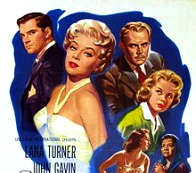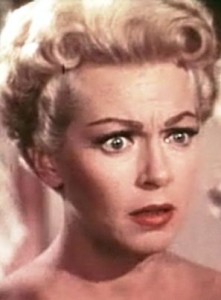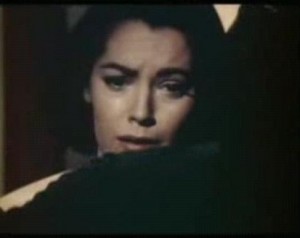Imitation of Life (1959 film)

Imitation of Life: “I’m White”
A struggling young actress with a six-year-old daughter sets up housekeeping with a homeless black widow and her light-skinned eight-year-old daughter who rejects her mother by trying to pass for white.
 Film poster by Reynold Brown
Film poster by Reynold Brown
Imitation of Life is a 1959 film directed by Douglas Sirk, produced by Ross Hunterand released by Universal Pictures, starring Lana Turner and John Gavin. It was Sirk’s final Hollywood film and dealt with issues of race, class and gender.
The cast also features Sandra Dee, Dan O’Herlihy, Susan Kohner, Robert Alda and Juanita Moore as Annie Johnson. Kohner and Moore received Academy Awardnominations for their performances. Gospel music star Mahalia Jackson appears as a church choir soloist.
The film is an adaptation of Fannie Hurst‘s novel of the same name. It is the second film adaptation of the novel. The first film was released in 1934.
Plot
In 1947, widow Lora Meredith (Lana Turner) dreams of becoming a famous Broadway actress. Losing track of her young daughter Susie at the beach (portrayed as a child by Terry Burnham), she asks a stranger named Steve Archer (John Gavin) to help her find the girl. Susie is found and looked after by Annie Johnson (Juanita Moore), a black divorcee with a daughter, Sarah Jane (portrayed as a child by Karin Dicker), who is about Susie’s age. Unlike her mother, Sarah Jane shows her mixed-race ancestry and can pass for white, which she does with fierce zeal and fervor. In return for Annie’s kindness, Lora takes Annie and her daughter in temporarily. Annie persuades Lora to let her stay, so that the widow can pursue an acting career.
With struggles along the way, Lora becomes a star of stage comedies, with Alan Loomis (Robert Alda) as her agent and David Edwards (Dan O’Herlihy) as her chief playwright. Although Lora had begun a relationship with Steve Archer, the stranger she met at the beach, their courtship falls apart because he does not want her to be a star. Lora’s concentration on her career prevents her from spending time with her daughter, who sees more of Annie. Annie and Sarah Jane have their own problems, as Sarah Jane is struggling with her mixed-race identity and wants to pass for white because of its privileges in the society.
Eleven years later, in 1958, Lora is a highly regarded Broadway star living in a luxurious home in New York. Annie continues to live with her, serving all at once as nanny, housekeeper, confidant and best friend. After rejecting David’s latest script (and his marriage proposal), Lora takes a role in a dramatic play. At the show’s after-party, she meets Steve, whom she has not seen in a decade. The two slowly begin rekindling their relationship, and Steve is reintroduced to Annie and the now-teenaged Susie (Sandra Dee) and Sarah Jane (Susan Kohner). When Lora is signed to star in an Italian motion picture, she leaves Steve to watch after Susie, and the teenager develops an unrequited crush on her mother’s boyfriend.
 Juanita Moore (right)
Juanita Moore (right)
Sarah Jane continues to pass as white and begins dating a white boy (Troy Donahue). He beats her after learning her mother is black.
Some time later, Sarah Jane passes for white to get a job performing at a seedy nightclub, but she tells her mother she is working at the library. When Annie learns the truth, she goes to the club to claim her daughter; Sarah Jane is fired. Her rejection of her mother begins taking a physical and mental toll on Annie. When Lora returns from Italy, Sarah Jane has run away from home. She asks Steve to hire a detective to find her. The detective locates Sarah Jane in California, living as a white woman under an assumed name and working as a chorus girl. Annie, becoming weaker and more depressed by the day, flies out to California to see her daughter one last time and say goodbye.
Annie is bedridden upon her return to New York, and Lora and Susie look after her. The issue of Susie’s crush on Steve becomes serious when Susie learns that Steve and Lora are to be married. Annie tells Lora of the girl’s crush. After a confrontation with her mother, Susie decides to go away to school in Denver, Colorado, to forget about Steve. Not long after Susie leaves, Annie passes away, presumably of a “broken heart.”
As she wished, Annie is given a lavish funeral in a large church, complete with a gospel choir (and a solo by gospel star Mahalia Jackson), followed by an elaborate traditional funeral procession with brass band and horse-drawn hearse. Just before the procession sets off, Sarah Jane tears through the crowd of mourners and throws herself upon her mother’s casket, begging forgiveness. Lora takes Sarah Jane to their limousine to join her, Susie, and Steve as the procession slowly travels through the city.
Cast:
- Lana Turner as Lora Meredith
- John Gavin as Steve Archer
- Sandra Dee as Susie, age 17
- Susan Kohner as Sarah Jane, age 19
- Robert Alda as Allen Loomis
- Dan O’Herlihy as David Edwards
- Juanita Moore as Annie Johnson
- Karin Dicker as Sarah Jane, age 8
- Terry Burnham as Susie, age 6
- Ann Robinson as Showgirl
- Troy Donahue as Frankie
- Sandra Gould as Annette
- Jack Weston as Tom
- Mahalia Jackson as Choir soloist
- Susan Kohner’s singing voice dubbed by Jo Ann Greer
History and Production
The plot of the 1959 version of Imitation of Life was significantly altered from the original book and the 1934 film version. In the original story, the “Lora” character, Bea Pullman, became famous with the help of her maid Delilah’s family waffle recipe (the 1934 film version features a family pancake recipe instead of a waffle recipe). As a result, Bea, the white businesswoman, becomes rich. Delilah is offered 20% of the profits, but declines and chooses to remain Bea’s dutiful servant.
Director Douglas Sirk and screenwriters Eleanore Griffin and Allan Scott felt that such a story would not be accepted in the years of civil rights milestones such as the Brown v. Board of Education case and the Montgomery Bus Boycott, but racial discrimination was still part of it. The story was altered so that Lora becomes a Broadway star with her own talents, with Annie assisting her by serving as a nanny for Lora’s child. In addition, producer Ross Hunter was cannily aware that these plot changes would enable Lana Turner to model an array of glamorous costumes and real jewels, something that would appeal to the female audience at that time.
Fredi Washington, the actress who played “the young mulatto” Peola in the 1934 film, was a “light-skinned” African American (of mixed-race African and European ancestry). She turned down offers by Hollywood agents to “pass for white” in order to become a star.
In 1945 she said,
“You see I’m a mighty proud gal and I can’t for the life of me, find any valid reason why anyone should lie about their origin or anything else for that matter. Frankly, I do not ascribe to the stupid theory of white supremacy and to try to hide the fact that I am a Negro for economic or any other reasons, if I do I would be agreeing to be a Negro makes me inferior and that I have swallowed whole hog all of the propaganda dished out by our fascist-minded white citizens.”
Although many African Americans were screen-tested for the Sarah Jane role in the 1959 remake, Susan Kohner, daughter of Lupita Tovar of Mexican descent, and Paul Kohner of Czech Jewish descent, won the role. Karin Dicker, of Jewish descent, made her debut in this film as the young Sarah Jane. Gospel singing star Mahalia Jackson received “presenting” billing for her one scene, performing a version of “Trouble of the World” at Annie’s funeral service.
Lana Turner’s wardrobe for Imitation of Life cost over $1.078 million, making it one of the most expensive in cinema history at that time. Lana Turner’s jewels throughout the film were provided by famed Los Angeles jeweler Laykin et Cie.
Release and Critical Reaction
Sirk’s Imitation of Life premiered in New York City on April 17, 1959, and Universal put the film into general release on April 30. Though it was not well-reviewed upon its original release — many critics derided the film as a “soap opera” — Imitation of Lifewas the fourth most successful motion picture of 1959, grossing $6.4 million. Imitation of Life was Universal-International’s top-grossing film that year, and remained Universal’s most successful film until the release of Airport in 1970.
Both Moore and Kohner were nominated for the 1959 Academy Award for Best Supporting Actress and the 1959 Golden Globe Award for Best Supporting Actress. While neither actress won the Oscar, Kohner won the Golden Globe award, as well as another for Best New Actress. Moore won second place in the category of Top Female Supporting Performance at the 1959 Laurel Awards, and the film won Top Drama. Douglas Sirk was nominated for the 1959 Directors Guild of America Award.
Today, Imitation of Life has been re-evaluated by critics and is now held up as a masterpiece of Douglas Sirk’s directing style. Emanuel Levy has written, “One of the four masterpieces directed in the 1950s, the visually lush, meticulously designed and powerfully acted ‘Imitation of Life’ was the jewel in Sirk’s crown, ending his Hollywood’s career before he returned to his native Germany.” Sirk provided the Annie–Sarah Jane relationship in his version with more screen time and more intensity than the original versions of the story, and critics later commented that Juanita Moore and Susan Kohner stole the film from Turner. Sirk later said that he had deliberately and subversively undercut Turner to draw focus toward the problems of the two black characters.
Sirk’s treatment of racial and class issues is also admired, for what he caught of the times. Writing in 1997, Rob Nelson said,
“Basically, we’re left to intuit that the black characters (and the movie) are themselves products of ’50s-era racism–which explains the film’s perspective, but hardly makes it less dizzying. Possibly thinking of W.E.B. DuBois‘s notion of African American double-consciousness, critic Molly Haskell once described ‘Imitation’s’ double-vision: “The black girl’s agonizing quest for her identity is not seen from her point of view as much as it is mockingly reflected in the fun house mirrors of the culture from which she is hopelessly alienated.”
Imitation of Life later became a staple of both the American Movie Classics and Turner Classic Movies cable television networks. Both versions of the film were issued in 2003 on a double-sided DVD from Universal Home Entertainment; a two-disc set of the films was issued by Universal in 2008. Madman Entertainment‘s Directors Suite label in Australia has released a three disc DVDset, including also the John M. Stahl original Imitation of Life. Todd Haynes‘ Far from Heaven (2002) is an homage to Sirk’s work, in particular All That Heaven Allows. The 1969 Diana Ross & the Supremes song “I’m Livin’ in Shame” and the 2001 R.E.M. song “Imitation of Life” are based upon this film.
Awards and Nominations
- Laurel Awards
- Top Drama
- Top Female Supporting Performance (Juanita Moore) – 2nd place
- Top Cinematography — Color (Russell Metty) – Nomination, 5th place
- Academy Awards
- Best Supporting Actress (Susan Kohner) – Nomination
- Best Supporting Actress (Juanita Moore) – Nomination
- Golden Globes
- Best Supporting Actress (Susan Kohner)
- Best Supporting Actress (Juanita Moore) – Nomination
- Directors Guild of America Award
- Outstanding Directorial Achievement in Motion Pictures (Douglas Sirk) – Nomination




